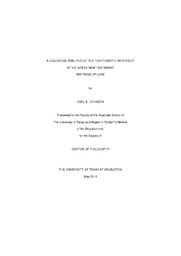| dc.contributor.author | Johnson, Carl E. | en_US |
| dc.date.accessioned | 2010-07-19T19:55:31Z | |
| dc.date.available | 2010-07-19T19:55:31Z | |
| dc.date.issued | 2010-07-19 | |
| dc.date.submitted | January 2010 | en_US |
| dc.identifier.other | DISS-10175 | en_US |
| dc.identifier.uri | http://hdl.handle.net/10106/4966 | |
| dc.description.abstract | Motivated by Bloomfield's belief that linguistic variation is not without motivation, this paper seeks to determine the distinction between the morphological imperfect and periphrastic imperfect of Koine Greek within the New Testament writings of Luke.This study suggests that: 1. The periphrastic imperfect occurs only within narrative sections of the New Testament and is most prominent in the writings of Luke.2. The number of periphrastic imperfects has been recently over reported.3. The periphrastic imperfect is a more marked form of Koine Greek which developed in accordance with general rules of grammaticalization.4. The discourse function of periphrastic imperfects has not been previously cataloged because traditional codification has been limited to the confines of the sentence, their existence was merely attributed to Aramaic influence, and their uniqueness was largely ignored.5. Just as Longacre has shown the historical present to provide highlighted storyline, the periphrastic imperfect provides highlighted background and can be ranked accordingly.6. The Periphrastic imperfect highlights background for introductory or linking purposes by presenting particularly salient information concerning location and/or action. This suggests the following four categories:a. INTRODUCTORY LOCATIVE which highlights action whose placement in a specific location or time is important to the subsequent narrative. Both location and action are important.b. LINKING LOCATIVE which highlights action in a specific physical location or time which links the passage to a previous or subsequent narrative which involves the same participants in the same or similar action. Both location and action are important.c. INTRODUCTORY ACTION which highlights the involvement of the subject(s) in an action which is important to the subsequent narrative.d. LINKING ACTION which highlights involvement of the subject(s) in an action which links the passage to a previous or subsequent narrative involving the same participant(s) in the same or similar action. 7. Therefore, a Lukan periphrastic imperfect unites an imperfect form of eivmi, (be) with a nominative present participle which agrees in number with the subject of the copula in order to express a highlighted, ongoing state or action which may occur in a spatial or temporal sphere. Said action is usually agentive.After an initial examination of a reduced number of tokens, I developed a definition for the periphrastic imperfect which addresses both form and function. I used that definition to reexamine each of the tokens proposed by Boyer (Boyer, 1986) as well as those from my own reduced list. In Chapter 3, genuine periphrastic imperfects are grouped by function and discussed in detail. Chapter 4 summarizes my findings and provides additional support for the same. In Appendix E, I list all periphrastic imperfects found in the writings of Luke. In Appendix F, I list all of the overt tokens excluded from Boyer's list. | en_US |
| dc.description.sponsorship | Edmondson, Jerold | en_US |
| dc.language.iso | EN | en_US |
| dc.publisher | Linguistics | en_US |
| dc.title | A Discourse Analysis Of The Periphrastic Imperfect In The Greek New Testament Writings Of Luke | en_US |
| dc.type | Ph.D. | en_US |
| dc.contributor.committeeChair | Edmondson, Jerold | en_US |
| dc.degree.department | Linguistics | en_US |
| dc.degree.discipline | Linguistics | en_US |
| dc.degree.grantor | University of Texas at Arlington | en_US |
| dc.degree.level | doctoral | en_US |
| dc.degree.name | Ph.D. | en_US |
| dc.identifier.externalLink | https://www.uta.edu/ra/real/editprofile.php?onlyview=1&pid=1555 | |
| dc.identifier.externalLinkDescription | Link to Research Profiles | |

